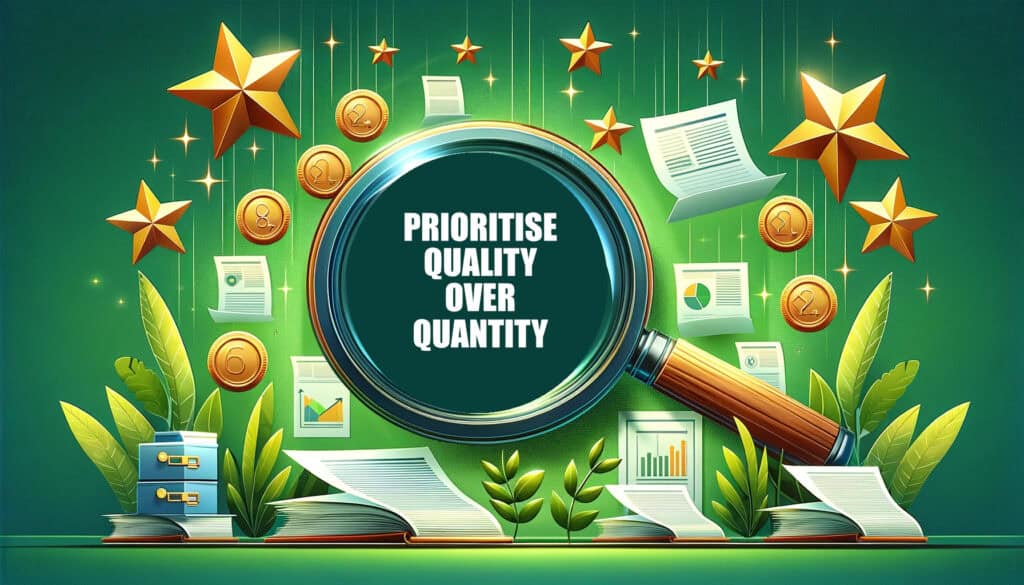
Developing evergreen content is essential for any website looking to attract consistent traffic over time. Evergreen content refers to material that remains relevant and valuable to readers long after publication. Unlike trendy topics that lose relevance quickly, evergreen content can drive long-term SEO benefits and ongoing engagement from your audience.
This post will explore ten proven strategies for developing evergreen content. These strategies will help you create content that not only stands the test of time but continues to provide value and attract readers year after year. From selecting suitable topics to optimizing for SEO, these tips will ensure your content remains relevant and practical.
Evergreen content is beneficial for building a robust digital presence because it provides continuous traffic without requiring frequent updates. It also helps establish authority in your niche, as well-researched and enduring content showcases your expertise. Moreover, evergreen content has a compounding effect on SEO, as it accumulates backlinks and social shares over time, further boosting its visibility and impact.
Strategy 1: Focus on Timeless Topics
Focusing on timeless topics is crucial when developing evergreen content. Timeless topics remain relevant regardless of trends or current events. They address fundamental questions, provide essential information, or solve common problems that people will always be interested in.
For example, topics like “healthy eating habits” or “benefits of regular exercise” are timeless in the health niche. In technology, subjects like “basic programming principles” or “how to secure your online accounts” are evergreen. Identifying these topics requires understanding your audience’s core interests and needs, ensuring that your content remains functional and sought after over time.
To find timeless topics, use tools like Google Trends to identify stable interest levels over time. Additionally, consult evergreen content from competitors to see what types of topics have consistently performed well. By focusing on subjects with enduring appeal, you can create relevant and valuable content to your audience for years to come.
Strategy 2: Conduct Comprehensive Research
Comprehensive research is the backbone of developing evergreen content. Accurate and well-researched information enhances your content’s credibility and ensures its longevity. Readers trust content backed by reliable data and thorough analysis, making them more likely to return and share it with others.
Start by identifying credible sources and gathering as much relevant information as possible. Use academic journals, industry reports, and authoritative websites to build a solid foundation for your content. Organise your findings in a structured manner and incorporate them seamlessly into your writing to provide your readers with in-depth insights and valuable perspectives.
Comprehensive research also involves staying up-to-date with the latest developments in your field. To keep your knowledge current, regularly read industry publications, attend webinars, and participate in professional forums. You can maintain its relevance and authority over time by integrating the latest information and trends into your evergreen content.

Strategy 3: Prioritize Quality Over Quantity
When developing evergreen content, prioritizing quality over quantity is essential. High-quality content is informative, engaging, and well-written, which helps it stand out and remain relevant over time. Focus on creating comprehensive and detailed articles that cover topics thoroughly, providing readers with all the information they need in one place.
Quality content also involves proper formatting, explicit language, and a logical structure. Subheadings, bullet points, and visuals can break up text and enhance readability. By investing time and effort into crafting exceptional content, you can ensure it continues to attract and retain readers long after its initial publication.
High-quality, evergreen content also requires thorough editing and proofreading. Errors and inconsistencies can undermine your credibility and detract from the reader’s experience. Use tools like Grammarly and Hemingway to check for grammar and readability issues. Additionally, consider getting feedback from colleagues or professional editors to refine your content further.
Strategy 4: Optimize for SEO
Optimising for SEO is a critical aspect of developing evergreen content. Effective SEO strategies help your content rank higher in search engine results, making it easier for readers to find. Conduct keyword research to identify terms and phrases relevant to your topic and audience.
Incorporate these keywords naturally throughout your content, including titles, headings, and meta descriptions. Use internal and external links to enhance your content’s credibility and provide additional resources for readers. By focusing on SEO, you can improve your content’s visibility and ensure it continues to attract traffic over time.
In addition to keyword optimisation, ensure your content is mobile-friendly and has a fast loading time, as these factors significantly impact SEO rankings. Use tools like Google’s PageSpeed Insights to assess and improve your site’s performance. A well-optimized evergreen article ranks higher and provides a better user experience, leading to higher engagement and lower bounce rates.
Strategy 5: Use Clear and Concise Language
Clear and concise language is vital when developing evergreen content. Readers should be able to understand your message easily without needing to decipher complex jargon or convoluted sentences. Aim to write straightforwardly and engagingly that keeps your audience’s attention.
Use simple language, short sentences, and an active voice to achieve this. Only unnecessary technical terms if they are essential to the topic, and always provide explanations or definitions when needed. Tools like readability checkers can help you assess and improve the clarity of your content, ensuring it remains accessible to a broad audience.
Additionally, consider your audience’s level of expertise. Tailor your language and explanations to suit their knowledge level, whether they are beginners or experts. Providing clear, well-structured information makes your content more approachable. It increases the likelihood that readers will share it, extending its reach and impact.

Strategy 6: Incorporate Visuals and Multimedia
Incorporating visuals and multimedia can significantly enhance your evergreen content. Images, infographics, videos, and other multimedia elements help break up text and make your content more engaging and visually appealing. They also aid in explaining complex concepts and keeping readers interested.
When choosing visuals, and developing evergreen content, ensure they are high quality and relevant to your content. Infographics can be particularly effective for summarizing key points and presenting data in an easily digestible format. Videos can provide additional insights and tutorials that complement your written content. By integrating multimedia elements, you can create a richer and more engaging experience for your readers.
Visuals also improve content retention, as people are more likely to remember information presented visually appealingly. Use tools like Canva to create custom graphics and infographics that align with your brand. Ensure all multimedia elements are optimized for fast loading times to enhance the user experience and SEO performance.
Strategy 7: Update Content Regularly
Regular updates are essential for maintaining your content’s evergreen status. Even the most well-researched and timeless content can become outdated due to new information, changes in industry standards, or shifts in audience preferences. Regularly reviewing and updating your content ensures it remains accurate and relevant.
Create a schedule for content audits, during which you check for outdated information, broken links, and other issues. Update statistics, replace obsolete references, and add new insights or developments to keep your content fresh. By committing to regular updates, you can maintain the credibility and value of your evergreen content.
Additionally, updating your content allows you to optimize it further for SEO. Incorporate new keywords, refine meta descriptions, and adjust headings to align with current search trends. Announce updates on social media and through email newsletters to drive renewed traffic to your refreshed content.
Strategy 8: Promote Your Content Effectively
Effective promotion is critical to ensuring your evergreen content reaches a broad audience. Utilize various channels to distribute and promote your content, including social media, email marketing, and SEO. Social media platforms allow you to share your content with a broad audience and encourage engagement through comments and shares.
Email marketing can be used to notify your subscribers about new or updated content, driving traffic and engagement. Additionally, optimize your content for search engines to ensure it appears in relevant search results. By promoting your evergreen content effectively, you can maximize its reach and impact over time.
Consider leveraging partnerships and guest blogging opportunities to expand your content’s reach. Collaborate with influencers in your niche to share your content with their audience. Repurpose your evergreen content into different formats, such as podcasts or webinars, to appeal to a broader audience and increase longevity.

Strategy 9: Engage with Your Audience
Engaging with your audience is crucial for success when developing evergreen content. Interaction fosters community and encourages readers to return to your site. Encourage comments, feedback, and questions on your content to promote discussion and engagement.
Respond to comments and feedback promptly, showing your readers that you value their input. Use social media and other platforms to engage with your audience and build relationships. Fostering a sense of community can enhance the impact and longevity of your evergreen content.
Additionally, audience engagement can be used to gather insights for future content. Consider common questions and feedback to identify new evergreen topics that address your audience’s needs. This continuous loop of engagement and content creation helps maintain a vibrant and loyal readership.
Strategy 10: Analyze and Measure performance
Analyzing and measuring the performance when developing evergreen content is essential for continuous improvement. Use analytics tools to track key metrics such as traffic, engagement, and conversion rates. These insights can help you understand what works and what doesn’t, allowing you to make data-driven decisions.
Review your content’s performance regularly and identify areas for improvement. Use this data to refine your content strategy and develop new ideas. By consistently analyzing and measuring performance, you can ensure your evergreen content remains practical and relevant.
Consider setting up goals and conversion tracking in Google Analytics to measure specific actions, such as downloads, sign-ups, or purchases from your evergreen content. This data clarifies your content’s impact on your business objectives and helps you refine your approach to maximize results.
Conclusion – Developing Evergreen Content
Developing evergreen content is a powerful strategy for achieving long-term success in content marketing. By focusing on timeless topics, conducting comprehensive research, and prioritizing quality, you can create content that stands the test of time.
